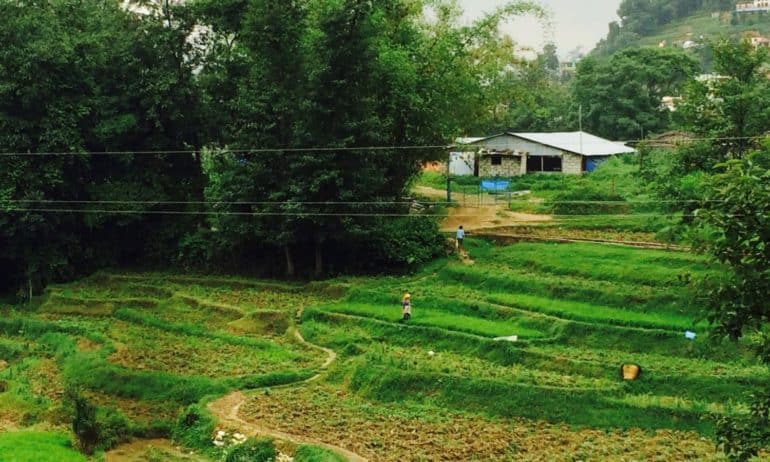The U.N. Food and Agriculture Organization’s (FAO) 2017 report on the State of Food Security and Nutrition (SOFI) estimates that 815 million people go hungry every day, despite the fact that more than enough food is produced to feed us all. Feeding the world is the most important challenge of our generation and, as urged in the 2030 Agenda for Sustainable Development, we need concerted efforts from all corners of the globe to eliminate hunger and food insecurity in our lifetime.
Many people think of hunger as not having enough (or any) food to eat, or having insufficient money for food, but the problem of food insecurity and hunger is far more complex. These factors, to list just a few, include adequate food production, healthy and safe cooking and eating practices, as well as sufficient nutrient intake to avert hidden hunger, or a lack of vitamins and minerals in daily diets.
How do forests fit into the picture of tackling food insecurity and hunger?
Although not so widely known, forests’ contributions to sustainable agriculture and improved food security and nutrition are vital. Covering one third of the earth’s land surface, forests are estimated to be a major resource for more than 2.4 billion people, who rely on forest goods and services for the direct provision of food, woodfuel, building materials, medicines, employment, and cash income.
Wood is used by about one-third of the world’s population to cook their food, while 750 million people use wood to boil water to make it safe for drinking. In economic terms, the sale of wood and non-wood products is valued at approximately US$730 billion globally, providing about 80 million people with an income. Moreover, forest foods are a regular part of rural diets and serve as safety nets in times of food scarcity. They include wild foods foraged from forests, which provide nourishment for millions of rural people, and wild animals and edible insects from forests which are often the main source of protein. Much of the world’s accessible fresh water comes from forested watersheds and wetlands, which supply 75 percent of domestic, agricultural, industrial, and ecological needs.
Forests also provide essential ecosystem services that support sustainable agriculture by regulating water flows, stabilizing soils, maintaining soil fertility, regulating the climate, and providing a viable habitat for wild pollinators and predators of agricultural pests. Forests are also key in regulating the climate. When managed sustainably, they can absorb about 10 percent of global carbon emissions, mitigating climate change and its impact on food production.
Despite its importance, the role of forests in food security and nutrition is often overlooked. According to FAO, 80 percent of the current global net forest loss of 3.3 million hectares per year is primarily driven by agricultural conversion—both the expansion of large-scale commercial agriculture and small-scale and subsistence agriculture.
As articulated in the Sustainable Development Goals (SDGs), the global community is striving towards a sustainable future for all. As part of this, forests and their roles in food security and nutrition will remain vital and integral parts of our livelihoods, either directly or indirectly, as they have been for millennia. Forests represent far more than natural resources and goods: they are part of human culture, identity, knowledge, and history, and especially for those who live in and near to them, they are central to their lives.
Moving forward, the urgency now is for greater recognition and reflection of the contribution of forests to food security and nutrition and their trade-offs in sustainable forestry, food security and agricultural policies, and policymaking. In fact, in October 2017, at a landmark session for the forestry sector, the 44th Session of the Committee on World Food Security (CFS) endorsed new and far-reaching voluntary policy recommendations on the role of sustainable forestry in achieving food security and nutrition. This was a major attempt at the global level to ensure the simultaneous attainment of sustainable forestry, agriculture, and food security and nutrition.
What more needs to be done?
Action can be taken to improve available data and information relevant to multi-sectoral policymaking in order to align food security and nutrition policies across the agriculture, forestry, livestock, fisheries, energy, mining, health, and other relevant sectors. In order to fully recognize and integrate forests’ contributions to food security and nutrition, policies will need to be formulated around the provision of secure land and forest tenure, and equitable access to resources.
The role of education and training is also key. Further capacity can be developed by expanding forestry studies in higher education institutions worldwide and changing their curricula. These should be adapted to reflect the latest information and knowledge on the complex and rapidly changing dynamics between sustainable forests, agriculture, and nutrition in the context of climate change, conflicts, population growth, and economic development.
In parallel, far greater forest-related research and development is needed, including more in-depth knowledge and innovative technology on how forest products can contribute further to diversified diets. This could include, for example, mapping the multiple health and nutrition properties of the edible forest foods that we all enjoy, as an authoritative area of research in tackling hidden hunger.
The future of forests and food security has a bearing on the wellbeing of every individual on this planet, and so integrated and concerted efforts are crucial. Only when our joint efforts are coupled with coordinated actions will our and future generations be able to fully appreciate the importance of forests for sustainable food security and nutrition as well as the many other benefits healthy forests provide.







